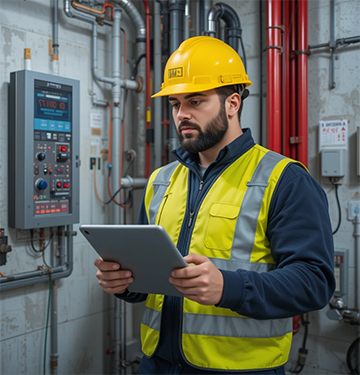Published: May 27, 2014 Updated: March 18, 2025
Essential Preventative Maintenance Checklists: A Comprehensive Guide
 For those managing facilities and equipment in reliability-focused industries, preventative maintenance (PM) forms a stable foundation of operational stability. A well-structured PM plan, especially when augmented by a computerized maintenance management system (CMMS), significantly reduces downtime and ensures safety. Let's explore a checklist of e3sstianl preventive maintenance.
For those managing facilities and equipment in reliability-focused industries, preventative maintenance (PM) forms a stable foundation of operational stability. A well-structured PM plan, especially when augmented by a computerized maintenance management system (CMMS), significantly reduces downtime and ensures safety. Let's explore a checklist of e3sstianl preventive maintenance.
From simple to advanced systems, a detailed preventative maintenance checklist remains indispensable. Most companies understand the value of preventative maintenance. Maintenance managers understand that proactive care extends the lifespan of assets, reduces costly repairs, and ensures a safe working environment.
But why is a PM checklist so critical? It boils down to human fallibility. Even seasoned professionals can overlook routine tasks. This oversight, however minor, can trigger a cascade of problems, leading to equipment failure or safety hazards. A PM checklist serves as a reliable guide, ensuring that technicians miss nothing.
Furthermore, these checklists provide a valuable record of completed work. This documentation proves due diligence, especially in the event of equipment malfunction or safety incidents. Having a clear, dated, and signed record offers evidence that maintenance protocols were followed. This level of accountability becomes important when auditors and regulators visit. You can show them CMMS documentation.
Creating Effective Preventative Maintenance Checklists for Facilities
Developing a universal PM checklist for every facility shows its impracticality because of the unique characteristics of each site. However, a structured approach allows you to create customized checklists tailored to your specific needs. Start by systematically breaking down your facility into manageable sections. For each section, create a dedicated checklist that details every necessary maintenance task.
Begin with the building's exterior, working from the roof down to the foundation. This top-down approach ensures that no area is overlooked. For each task, provide clear, actionable steps and include a checkbox for completion. Add fields for the date of completion and the initials or signature of the technician responsible. This documentation ensures accountability and provides a historical record of maintenance activities.
Roof Maintenance Checklist Example
Consider a checklist for roof maintenance. It might include:
- Clearing roof drains and gutters of debris.
- Inspecting for water leaks, damaged tiles, or shingles.
- Evaluating the integrity of previously repaired areas.
- Checking flashings for damage or deterioration.
- Identifying and inspecting potential leak areas.
The specifics of your roof checklist will depend on the roofing material and the unique characteristics of your building. For example, a flat roof would require different inspection points than a pitched shingle roof. The goal is to create a comprehensive list that addresses all potential issues.
Extending Checklists to Internal Systems and Equipment
Once you have addressed the building's exterior, move on to internal systems and equipment. This includes HVAC systems, boilers, plumbing fixtures, lighting, and safety equipment. For each system, create a separate checklist that details the required maintenance tasks and inspection points. For example, an HVAC checklist might include:
- Changing air filters.
- Inspecting and cleaning coils.
- Checking refrigerant levels.
- Testing thermostat operation.
- Inspecting ductwork for leaks or damage.
Similarly, a safety equipment checklist would cover fire extinguishers, smoke detectors, and emergency lighting. Look to manufacturer specifications and relevant safety standards for guidance on proper inspections.
Expanding Preventative Maintenance to Diverse Industries
The principles of preventative maintenance apply across various industries, each with unique requirements. Let's explore specific examples:
Healthcare Facilities
In healthcare, PM checklists mean patient safety and regulatory compliance. Consider these examples:
- Medical Equipment: Regular calibration and testing of diagnostic and therapeutic equipment, such as MRI machines, X-ray systems, and ventilators.
- Life Support Systems: Routine checks of emergency generators, oxygen supply systems, and alarm systems.
- Environmental Controls: Monitoring and maintaining air quality, temperature, and humidity in critical areas like operating rooms and intensive care units.
- Sterilization Equipment: Regular testing and maintenance of autoclaves and other sterilization devices.
Manufacturing Plants
Manufacturing environments require robust PM programs to minimize downtime and maintain production efficiency:
- Production Machinery: Regular lubrication, inspection, and calibration of assembly line equipment, CNC machines, and robotic systems.
- Material Handling Equipment: Routine checks of forklifts, cranes, and conveyor systems.
- Electrical Systems: Inspection of power distribution panels, transformers, and wiring for potential hazards.
- Compressed Air Systems: Monitoring and maintaining compressors, air dryers, and piping for leaks and efficiency.
Commercial Buildings
Commercial buildings require a comprehensive PM approach to ensure occupant comfort and safety:
- Elevators and Escalators: Regular inspections and maintenance of mechanical and electrical components.
- Plumbing Systems: Checking for leaks, blockages, and corrosion in pipes and fixtures.
- Fire Suppression Systems: Testing and maintaining sprinklers, fire alarms, and smoke detectors.
- Building Automation Systems: Monitoring and maintaining HVAC controls, lighting systems, and security systems.
 Transportation
Transportation
In the transportation industry, preventative maintenance provides safety and operational efficiency:
- Fleet Vehicles: Regular oil changes, tire rotations, and brake inspections.
- Rail Systems: Inspection of tracks, signals, and rolling stock.
- Aviation: Detailed inspections and maintenance of aircraft engines, airframes, and avionics.
- Marine Vessels: Regular checks of engines, hulls, and navigation systems.
Establish Preventive Maintenance Checklist in Your Operation
By implementing detailed preventative maintenance checklists tailored to your specific industry and assets, you have better oversight over assets, labor resources, compliance issues, and above all, safety concerns.. Remember that a CMMS gives you a powerful tool for creating, managing, and tracking these checklists. Look at MAPCON, the CMMS provider that gives you both simple and advanced checklist capabilities.
Mapcon / 800-922-4336
MAPCON CMMS software empowers you to plan and execute PM tasks flawlessly, thanks to its wealth of features and customizable options. Want to see it for yourself? Click the button below to get your FREE 30-day trial of MAPCON!
Try It FREE!